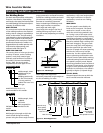
13
Operating Instructions and Parts Manual
AC or Alternating Current - electric
current that reverses direction
periodically. Sixty cycle current travels
in both directions sixty times per
second.
Arc Length - the distance from the
end of the electrode to the point
where the arc makes contact with the
work surface.
Base Metal - the material to be
welded.
Butt Joint - a joint between two
members aligned approximately in the
same plane.
Crater - a pool, or pocket, that is
formed as the arc comes in contact
with the base metal.
DC or Direct Current - electric
current which flows only in one
direction. The polarity (+ or -)
determines which direction the current
is flowing.
DC Reverse Polarity - occurs when
the electrode holder is connected to
the positive pole of the welding
machine. Reverse Polarity directs more
heat into melting the electrode rather
than the work piece. It is used on
thinner material.
DC Straight Polarity - occurs when
the electrode holder is connected to
the negative pole of the welding
machine. With straight polarity more
heat is directed to the work piece for
better penetration on thicker material.
Electrode - a coated metal wire
having approximately the same
composition as the material being
welded.
Fillet Weld - approximately a triangle
in cross-section, joining two surfaces at
right angles to each other in a lap, T or
corner joint.
Flux - a coating, when heated, that
produces a shielding gas around the
welding area. This gas protects the
parent and filler metals from
impurities in the air.
Flux Cored Arc Welding (FCAW) -
also called Gasless, is a welding process
used with a wire-feed welding
machine. The weld wire is tubular
with flux material contained inside for
shielding.
Gas Metal Arc Welding (GMAW) -
also called MIG, is a welding process
used with a wire feed welding
machine. The wire is solid and an inert
gas is used for shielding.
Gas Tungsten Arc Welding (GTAW)
- also called TIG, is a welding process
used with welding equipment with a
high frequency generator. The arc is
created between a non-consumable
tungsten electrode and the work
piece. Filler metal may or may not be
used.
Lap Joint - a joint between two
overlapping members in parallel
planes.
Open Circuit Voltage (OCV) - the
voltage between the electrode and the
work clamp of the welding machine
when no current is flowing (not
welding). The OCV determines how
quickly the arc is struck.
Overlap - occurs when the amperage
is set too low. In this instance, the
molten metal falls from the electrode
without actually fusing into the base
metal.
Porosity - gas pockets, or cavities,
formed during weld solidification.
They weaken the weld.
Penetration - the depth into the work
piece that has been heat effected by
the arc during the welding process. A
good weld achieves 100% penetration
meaning that the entire thickness of
the work piece has been heated and
resolidified. The heat effected area
should be easily seen on the opposite
side of the weld.
Shielded Metal Arc Welding
(SMAW) - also called Stick, is a
welding process with uses a
consumable electrode to support the
arc. Shielding is achieved by the
melting of the flux coating on the
electrode.
Slag - a layer of flux soot that protects
the weld from oxides and other
contaminants while the weld is
solidifying (cooling). Slag should be
removed after weld has cooled.
Spatter - metal particles thrown from
the weld which cool and harden on
the work surface. Spatter can be
minimized by using a spatter resistant
spray on the work piece before
welding.
Tack Weld - weld made to hold parts
in proper alignment until final welds
are made.
Travel Angle - the angle of the
electrode in the line of welding. It
varies from 5º to 45º depending on
welding conditions.
T Joint - made by placing the edge of
one piece of metal on the surface of
the other piece at approximately a 90º
angle.
Undercut - a condition that results
when welding amperage is too high.
The excessive amperage leaves a
groove in the base metal along both
sides of the bead which reduces the
strength of the weld.
Weld Pool or Puddle - a volume of
molten metal in a weld prior to its
solidification as weld metal.
Weld Bead - a narrow layer or layers
of metal deposited on the base metal
as the electrode melts. Weld bead
width is typically twice the diameter of
the electrode.
Work Angle - the angle of the
electrode from horizontal, measured
at right angles to the line of welding.
Glossary of Welding Terms
Model WG2040, WG2044, WG2045, WG3000
www.chpower.com


















